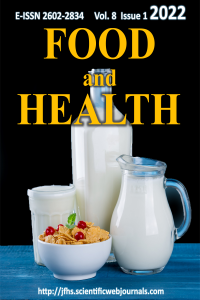Research Article
Year 2022,
Volume: 8 Issue: 1, 12 - 22, 01.01.2022
Abstract
Project Number
172L18
References
- Abe, L.T., Lajolo, F.M., Genovese, M.I. (2010). Comparison of phenol content and antioxidant capacity of nuts. Ciência e Tecnologia de Alimentos, 30, 254-259. https://doi.org/10.1590/S0101-20612010000500038
- Altun, B., Besler, T., Unal, S. (2002). Ankara’da Satılan Sütlerin Değerlendirilmesi, Sürekli Tıp Eğitimi Dergisi, 11(2), 51-55.
- Apak, R., Güçlü, K., Özyürek, M., Karademir, S. E. (2004). Novel Total Antioxidant Capacity Index for Dietary Polyphenols and Vitamins C and E, Using Their Cupric Ion Reducing Capability in the Presence of Neocuproine: CUPRAC Method. Journal of Agricultural and Food Chemistry, 52(26), 7970-7981. https://doi.org/10.1021/jf048741x
- Arabacioglu, O.Z. (1993). İçme Sütü Tüketiminin Arttırılması ve Okul Sütü Programları. 5. Türkiye Sütçülük Kongresi (p. 217) Ankara, Türkiye, 20-21 Mayıs 1993.
- Anonymous (2000). Official Methods of Analysis, 18th ed. AOAC Int., Gaithersburg, MD, USA.
- Atasoy, E., Altıngöz, Y. (2011). Dünya ve Türkiye'de Kestanenin Önemi ve Üretimi, İstanbul Üniversitesi Edebiyat Fakültesi Coğrafya Bölümü Coğrafya Dergisi 22, 1-13.
- Bajwa, U., Mittal, S. (2013). Quality characteristics of no added sugar ready to drink milk supplemented with mango pulp. Journal of Food Science and Technology, 52(4), 2112-2120. https://doi.org/10.1007/s13197-013-1184-7
- Baysal, A. (2004). Beslenme. Hatiboğlu Yayınları, Ankara, Türkiye, p 268-275.
- Bernárdez, M.M., De la Montaña Miguélez, J., Queijeiro, J.G. (2004). HPLC determination of sugars in varieties of chestnut fruits from Galicia (Spain). Journal of Food Composition and Analysis, 17(1), 63-67. https://doi.org/10.1016/S0889-1575(03)00093-0
- Bounous, G., Botta, R., Beccaro, G. (2000). The chestnut: The Ultimate Energy Source Nutritional Value and Alimentary Benefits. NUCIS Newsletter, 9, 44-50.
- Candemir, A. (2011). Determining of quality characteristics of sliced Chestnut dried in fluidized bed drier and Microwave drier. Izmir, Turkey: Univ.Ege.
- Dassler, E., Heitmann, G. (1991). Obst und gemüse, Berlin: Verlag Paul Parey, German. P. 56-58.
- De Vasconcelos, M.D.C.B.M., Bennett, R.N., Quideau, S., Jacquet, R., Rosa, E.A.S., Ferreira-Cardoso, J.V. (2010). Evaluating the potential of chestnut (Castanea sativa Mill.) fruit pericarp and integument as a source of tocopherols, pigments and polyphenols. Industrial Crops and Products, 31(2), 301-311. https://doi.org/10.1016/j.indcrop.2009.11.008
- De Vasconcelos, M.D.C.B.M., Bennett, R.N., Rosa, E.A.S., Cardoso, J.V.F. (2007). Primary and Secondary Metabolite Composition of Kernels from Three Cultivars of Portuguese Chestnut (Castanea sativa Mill.) at Different Stages of Industrial Transformation. Journal of Agricultural and Food Chemistry, 55(9), 3508-3516. https://doi.org/10.1021/jf0629080
- Demirci, M. (1984). Laktozun insan beslenmesindeki önemi, Atatürk Üniversitesi Ziraat Fakültesi Dergisi, 15, 3-4.
- Diehl, J.F. (2002). Nuts shown to offer health benefits. International News on Fats, Oils and Related Materials, 13(2), 134-138.
- Ertan, K., Bayana, D., Gokce, O., Alatossava, J.T., Yilmaz, Y., Gursoy, O. (2017). Total antioxidant capacity and phenolic content of pasteurized and UHT-treated cow milk samples marketed in Turkey. Akademik Gıda, 15, 103-108. https://doi.org/10.24323/akademik-gida.333630
- Ertürk, Ü., Mert, C., Soylu, A. (2006). Chemical composition of fruits of some important chestnut cultivars. Brazilian Archives of Biology and Technology, 49(2), 183-188. https://doi.org/10.1590/S1516-89132006000300001
- FAO (2004). Calculatıon Of The Energy Content Of Foods - Energy Conversıon Factors. http://www.fao.org/3/Y5022E/y5022e04.htm(accessed May, 2018).
- Fox, P.F. (2003). Milk Proteins: General and Historical Aspects. In Fox, P.F & McSweeney, P.L.H. (Eds.), Advanced Dairy Chemistry—1 Proteins (p. 1-48). Boston, MA: Springer. https://doi.org/10.1007/978-1-4419-8602-3_1
- Johnsen, D. (1992). B. Holland, I.D. Unwin und D.H. Buss: Vegetables, Herbs and Spices. The Fifth Supplement to McCance and Widdowson’s The Composition of Foods (4th Edition). 163 Seiten. Royal Society of Chemistry, Cambridge 1991. Preis: 24,50 £. Food Nahrung 36(4), 432-432. https://doi.org/10.1002/food.19920360456
- Inanc, A.L., Cınar, I. (2009). Alternatif doğal tatlandırıcı: Stevya. Gıda, 34, 411-415.
- Kırdar, S. (2001). Süt ve Ürünleri Analiz Metodları Uygulama Kılavuzu, Isparta, Süleyman Demirel Üniversitesi, Süt Yayınları, Isparta, Türkiye.
- Kinghorn, A.D., Wu, C.D., Soejarto, D.D. (2001). Stevioside, In O’Brien Nabors, L. (Eds.), Alternative Sweeteners (p. 167-183). New York, NY: Marcel Dekker.
- Miller, G.D., Jarvis, K.J., McBean, L.D. (2000). Handbook of Dairy Foods and Nut¬ration, In Jensen, R.G. & Kroger, M. (Eds.), Handbook of Dairy Foods and Nut-rition. The Importance of Milk and Milk Products in the Diet (p. 4-24). New York, NY: CRC Press.
- Naczk, M., Shahidi, F. (2004). Extraction and analysis of phenolics in food. Journal of Chromatography A, 1054(1-2), 95-111. https://doi.org/10.1016/j.chroma.2004.08.059
- Neri, L., Dimitri, G., Sacchetti, G. (2010). Chemical composition and antioxidant activity of cured chestnuts from three sweet chestnut (Castanea sativa Mill.) ecotypes from Italy. Journal of Food Composition and Analysis, 23(1), 23-29. https://doi.org/10.1016/j.jfca.2009.03.002
- Nunes, A.P.M., Ferreira-Machado, S.C., Nunes, R.M., Dantas, F.J.S., De Mattos, J.C.P., Caldeira-de-Araújo, A. (2007). Analysis of genotoxic potentiality of stevioside by comet assay. Food and Chemical Toxicology, 45(4), 662-666. https://doi.org/10.1016/j.fct.2006.10.015
- Paixão, J.A., Rodrigues, J.B., Esmerino, E.A., Cruz, A.G., Bolini, H.M.A. (2014). Influence of temperature and fat content on ideal sucrose concentration, sweetening power, and sweetness equivalence of different sweeteners in chocolate milk beverage. Journal of Dairy Science, 97(12), 7344-7353. https://doi.org/10.3168/jds.2014-7995
- Selek, I. (2011). Research on some phenolic compounds of Walnut and chestnut. Ege University, Izmir, Turkey.
- Sonmez, C., Ertas, G., Okur, O.D., Güzel-Seydim, Z. (2010). UHT Sütlerin Bazı Kalite Kriterlerinin ve Antioksidan Aktivitelerinin Belirlenmesi. Akademik Gıda, 8, 13-16.
- Soylu, A. (2004). Kestane yetiştiriciliği ve özellikleri, Hasad yayıncılık Ltd.Şti, 2, p. 64
- Unal, R.N., Besler, H.T. (2008). Süt ve Sütün Beslenmedeki Önemi, Sağlık Bakanlığı Yayın, Ankara, Türkiye.
- Van Soest, P.J. (1994). Nutritional Ecology of the Ruminant. USA. Cornell University Press, p. 476. https://doi.org/10.7591/9781501732355
- Vitali, D., Dragojević, I.V., Šebečić, B. (2009). Effects of incorporation of integral raw materials and dietary fibre on the selected nutritional and functional properties of biscuits. Food Chemistry, 114(4), 1462-1469. https://doi.org/10.1016/j.foodchem.2008.11.032
- Yurdakul, E. (2008). Evaluation of the quality criteria of freeze dried chestnut produced for enrichment of breakfast cereal products. Ege University, Izmir, Turkey.
Effects of chestnut addition on physicochemical composition, total phenolic contents, antioxidant capacities and sensory properties of milk
Abstract
Chestnut-added milk (CM) was produced with 2 different methods. In the first method, chestnuts were roasted, and in the second method, they were cooked in bain-marie and then added to milk at different ratios (5, 15, 25 %). The addition of chestnuts to milk statistically increased the amount of protein, dietary fiber, carbohydrate, energy, mineral (Ca, K, P, Mg), antioxidant capacity and total phenolic content compared to the control, whereas it did not cause a significant change in sensory properties. Therefore, the chestnut is a suitable supplementation for milk.
Keywords
Supporting Institution
This work was supported by the Scientific Research Council of Bursa Technical University.
Project Number
172L18
References
- Abe, L.T., Lajolo, F.M., Genovese, M.I. (2010). Comparison of phenol content and antioxidant capacity of nuts. Ciência e Tecnologia de Alimentos, 30, 254-259. https://doi.org/10.1590/S0101-20612010000500038
- Altun, B., Besler, T., Unal, S. (2002). Ankara’da Satılan Sütlerin Değerlendirilmesi, Sürekli Tıp Eğitimi Dergisi, 11(2), 51-55.
- Apak, R., Güçlü, K., Özyürek, M., Karademir, S. E. (2004). Novel Total Antioxidant Capacity Index for Dietary Polyphenols and Vitamins C and E, Using Their Cupric Ion Reducing Capability in the Presence of Neocuproine: CUPRAC Method. Journal of Agricultural and Food Chemistry, 52(26), 7970-7981. https://doi.org/10.1021/jf048741x
- Arabacioglu, O.Z. (1993). İçme Sütü Tüketiminin Arttırılması ve Okul Sütü Programları. 5. Türkiye Sütçülük Kongresi (p. 217) Ankara, Türkiye, 20-21 Mayıs 1993.
- Anonymous (2000). Official Methods of Analysis, 18th ed. AOAC Int., Gaithersburg, MD, USA.
- Atasoy, E., Altıngöz, Y. (2011). Dünya ve Türkiye'de Kestanenin Önemi ve Üretimi, İstanbul Üniversitesi Edebiyat Fakültesi Coğrafya Bölümü Coğrafya Dergisi 22, 1-13.
- Bajwa, U., Mittal, S. (2013). Quality characteristics of no added sugar ready to drink milk supplemented with mango pulp. Journal of Food Science and Technology, 52(4), 2112-2120. https://doi.org/10.1007/s13197-013-1184-7
- Baysal, A. (2004). Beslenme. Hatiboğlu Yayınları, Ankara, Türkiye, p 268-275.
- Bernárdez, M.M., De la Montaña Miguélez, J., Queijeiro, J.G. (2004). HPLC determination of sugars in varieties of chestnut fruits from Galicia (Spain). Journal of Food Composition and Analysis, 17(1), 63-67. https://doi.org/10.1016/S0889-1575(03)00093-0
- Bounous, G., Botta, R., Beccaro, G. (2000). The chestnut: The Ultimate Energy Source Nutritional Value and Alimentary Benefits. NUCIS Newsletter, 9, 44-50.
- Candemir, A. (2011). Determining of quality characteristics of sliced Chestnut dried in fluidized bed drier and Microwave drier. Izmir, Turkey: Univ.Ege.
- Dassler, E., Heitmann, G. (1991). Obst und gemüse, Berlin: Verlag Paul Parey, German. P. 56-58.
- De Vasconcelos, M.D.C.B.M., Bennett, R.N., Quideau, S., Jacquet, R., Rosa, E.A.S., Ferreira-Cardoso, J.V. (2010). Evaluating the potential of chestnut (Castanea sativa Mill.) fruit pericarp and integument as a source of tocopherols, pigments and polyphenols. Industrial Crops and Products, 31(2), 301-311. https://doi.org/10.1016/j.indcrop.2009.11.008
- De Vasconcelos, M.D.C.B.M., Bennett, R.N., Rosa, E.A.S., Cardoso, J.V.F. (2007). Primary and Secondary Metabolite Composition of Kernels from Three Cultivars of Portuguese Chestnut (Castanea sativa Mill.) at Different Stages of Industrial Transformation. Journal of Agricultural and Food Chemistry, 55(9), 3508-3516. https://doi.org/10.1021/jf0629080
- Demirci, M. (1984). Laktozun insan beslenmesindeki önemi, Atatürk Üniversitesi Ziraat Fakültesi Dergisi, 15, 3-4.
- Diehl, J.F. (2002). Nuts shown to offer health benefits. International News on Fats, Oils and Related Materials, 13(2), 134-138.
- Ertan, K., Bayana, D., Gokce, O., Alatossava, J.T., Yilmaz, Y., Gursoy, O. (2017). Total antioxidant capacity and phenolic content of pasteurized and UHT-treated cow milk samples marketed in Turkey. Akademik Gıda, 15, 103-108. https://doi.org/10.24323/akademik-gida.333630
- Ertürk, Ü., Mert, C., Soylu, A. (2006). Chemical composition of fruits of some important chestnut cultivars. Brazilian Archives of Biology and Technology, 49(2), 183-188. https://doi.org/10.1590/S1516-89132006000300001
- FAO (2004). Calculatıon Of The Energy Content Of Foods - Energy Conversıon Factors. http://www.fao.org/3/Y5022E/y5022e04.htm(accessed May, 2018).
- Fox, P.F. (2003). Milk Proteins: General and Historical Aspects. In Fox, P.F & McSweeney, P.L.H. (Eds.), Advanced Dairy Chemistry—1 Proteins (p. 1-48). Boston, MA: Springer. https://doi.org/10.1007/978-1-4419-8602-3_1
- Johnsen, D. (1992). B. Holland, I.D. Unwin und D.H. Buss: Vegetables, Herbs and Spices. The Fifth Supplement to McCance and Widdowson’s The Composition of Foods (4th Edition). 163 Seiten. Royal Society of Chemistry, Cambridge 1991. Preis: 24,50 £. Food Nahrung 36(4), 432-432. https://doi.org/10.1002/food.19920360456
- Inanc, A.L., Cınar, I. (2009). Alternatif doğal tatlandırıcı: Stevya. Gıda, 34, 411-415.
- Kırdar, S. (2001). Süt ve Ürünleri Analiz Metodları Uygulama Kılavuzu, Isparta, Süleyman Demirel Üniversitesi, Süt Yayınları, Isparta, Türkiye.
- Kinghorn, A.D., Wu, C.D., Soejarto, D.D. (2001). Stevioside, In O’Brien Nabors, L. (Eds.), Alternative Sweeteners (p. 167-183). New York, NY: Marcel Dekker.
- Miller, G.D., Jarvis, K.J., McBean, L.D. (2000). Handbook of Dairy Foods and Nut¬ration, In Jensen, R.G. & Kroger, M. (Eds.), Handbook of Dairy Foods and Nut-rition. The Importance of Milk and Milk Products in the Diet (p. 4-24). New York, NY: CRC Press.
- Naczk, M., Shahidi, F. (2004). Extraction and analysis of phenolics in food. Journal of Chromatography A, 1054(1-2), 95-111. https://doi.org/10.1016/j.chroma.2004.08.059
- Neri, L., Dimitri, G., Sacchetti, G. (2010). Chemical composition and antioxidant activity of cured chestnuts from three sweet chestnut (Castanea sativa Mill.) ecotypes from Italy. Journal of Food Composition and Analysis, 23(1), 23-29. https://doi.org/10.1016/j.jfca.2009.03.002
- Nunes, A.P.M., Ferreira-Machado, S.C., Nunes, R.M., Dantas, F.J.S., De Mattos, J.C.P., Caldeira-de-Araújo, A. (2007). Analysis of genotoxic potentiality of stevioside by comet assay. Food and Chemical Toxicology, 45(4), 662-666. https://doi.org/10.1016/j.fct.2006.10.015
- Paixão, J.A., Rodrigues, J.B., Esmerino, E.A., Cruz, A.G., Bolini, H.M.A. (2014). Influence of temperature and fat content on ideal sucrose concentration, sweetening power, and sweetness equivalence of different sweeteners in chocolate milk beverage. Journal of Dairy Science, 97(12), 7344-7353. https://doi.org/10.3168/jds.2014-7995
- Selek, I. (2011). Research on some phenolic compounds of Walnut and chestnut. Ege University, Izmir, Turkey.
- Sonmez, C., Ertas, G., Okur, O.D., Güzel-Seydim, Z. (2010). UHT Sütlerin Bazı Kalite Kriterlerinin ve Antioksidan Aktivitelerinin Belirlenmesi. Akademik Gıda, 8, 13-16.
- Soylu, A. (2004). Kestane yetiştiriciliği ve özellikleri, Hasad yayıncılık Ltd.Şti, 2, p. 64
- Unal, R.N., Besler, H.T. (2008). Süt ve Sütün Beslenmedeki Önemi, Sağlık Bakanlığı Yayın, Ankara, Türkiye.
- Van Soest, P.J. (1994). Nutritional Ecology of the Ruminant. USA. Cornell University Press, p. 476. https://doi.org/10.7591/9781501732355
- Vitali, D., Dragojević, I.V., Šebečić, B. (2009). Effects of incorporation of integral raw materials and dietary fibre on the selected nutritional and functional properties of biscuits. Food Chemistry, 114(4), 1462-1469. https://doi.org/10.1016/j.foodchem.2008.11.032
- Yurdakul, E. (2008). Evaluation of the quality criteria of freeze dried chestnut produced for enrichment of breakfast cereal products. Ege University, Izmir, Turkey.
There are 36 citations in total.
Details
| Primary Language | English |
|---|---|
| Subjects | Food Engineering |
| Journal Section | Research Article |
| Authors | |
| Project Number | 172L18 |
| Early Pub Date | November 12, 2021 |
| Publication Date | January 1, 2022 |
| Submission Date | March 29, 2021 |
| Published in Issue | Year 2022 Volume: 8 Issue: 1 |
Journal is licensed under a
CreativeCommons Attribtion-ShareAlike 4.0 International Licence 


Diamond Open Access refers to a scholarly publication model in which journals and platforms do not charge fees to either authors or readers.
Open Access Statement:
This is an open access journal which means that all content is freely available without charge to the user or his/her institution. Users are allowed to read, download, copy, distribute, print, search, or link to the full texts of the articles, or use them for any other lawful purpose, without asking prior permission from the publisher or the author. This is in accordance with the BOAI definition of open access.
Archiving Policy:
Archiving is done according to ULAKBİM "DergiPark" publication policy (LOCKSS).

